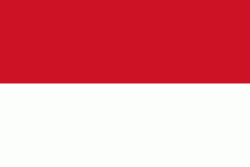Atambua
Atambua is the regency seat of Belu Regency, East Nusa Tenggara, Indonesia.
The town stretches as far as 8.5 km from north to south and 5 km from east to west, and is located in the north of the western half of Timor Island. The town is located at an altitude of about 350 m above sea level with temperatures ranging between 23 and 35 degrees Celsius making this area feel quite warm.
An influx of citizens fleeing from East Timor in 1999 made Atambua a big town. It is now the second-largest town in West Timor behind Kupang, also the fourth-largest town in East Nusa Tenggara behind Kupang, Maumere and Ende. Most of its citizens speak Tetun and Dawan. Atambua is a multi-ethnic town with most of its citizens from Timor, Rote, Sabu, and Flores with some emigrants from East Timor and China. But in spite of diversity, the citizens still live in harmony.
The town's religion is made up of over 90% of Roman Catholic, 5% of Protestant and a few more of Muslim, Hindu, and Buddhist. The town is home to the Roman Catholic Diocese of Atambua. The Diocese's population is over 95% Catholic, among the highest percentages of Catholics in all of Indonesia.
Atambua was founded by the Dutch in October 1916, having moved from Atapupu, a port village in Kakuluk Mesak. Atambua was briefly occupied by the Imperial Japanese Army from 1942 to 1943. They planted many trees, which can be seen in Hutan Jati Nenuk. After Independence, Indonesia's first president, Sukarno went to Atambua and planted more trees in the place now called Lapangan Umum. The most notable tree planted there is the banyan tree. In September 1999, more than 250,000 refugees arrived here from East Timor, after their vote for independence and the following violence. As late as 2002, an estimated 60,000 refugees remained in camps.
The town stretches as far as 8.5 km from north to south and 5 km from east to west, and is located in the north of the western half of Timor Island. The town is located at an altitude of about 350 m above sea level with temperatures ranging between 23 and 35 degrees Celsius making this area feel quite warm.
An influx of citizens fleeing from East Timor in 1999 made Atambua a big town. It is now the second-largest town in West Timor behind Kupang, also the fourth-largest town in East Nusa Tenggara behind Kupang, Maumere and Ende. Most of its citizens speak Tetun and Dawan. Atambua is a multi-ethnic town with most of its citizens from Timor, Rote, Sabu, and Flores with some emigrants from East Timor and China. But in spite of diversity, the citizens still live in harmony.
The town's religion is made up of over 90% of Roman Catholic, 5% of Protestant and a few more of Muslim, Hindu, and Buddhist. The town is home to the Roman Catholic Diocese of Atambua. The Diocese's population is over 95% Catholic, among the highest percentages of Catholics in all of Indonesia.
Atambua was founded by the Dutch in October 1916, having moved from Atapupu, a port village in Kakuluk Mesak. Atambua was briefly occupied by the Imperial Japanese Army from 1942 to 1943. They planted many trees, which can be seen in Hutan Jati Nenuk. After Independence, Indonesia's first president, Sukarno went to Atambua and planted more trees in the place now called Lapangan Umum. The most notable tree planted there is the banyan tree. In September 1999, more than 250,000 refugees arrived here from East Timor, after their vote for independence and the following violence. As late as 2002, an estimated 60,000 refugees remained in camps.
Map - Atambua
Map
Country - Indonesia
 |
 |
| Flag of Indonesia | |
As the world's third largest democracy, Indonesia is a presidential republic with an elected legislature. It has 38 provinces, of which nine have special status. The country's capital, Jakarta, is the world's second-most populous urban area. Indonesia shares land borders with Papua New Guinea, East Timor, and the eastern part of Malaysia, as well as maritime borders with Singapore, Vietnam, Thailand, the Philippines, Australia, Palau, and India. Despite its large population and densely populated regions, Indonesia has vast areas of wilderness that support one of the world's highest level of biodiversity.
Currency / Language
| ISO | Currency | Symbol | Significant figures |
|---|---|---|---|
| IDR | Indonesian rupiah | Rp | 2 |
| ISO | Language |
|---|---|
| NL | Dutch language |
| EN | English language |
| ID | Indonesian language |
| JV | Javanese language |















